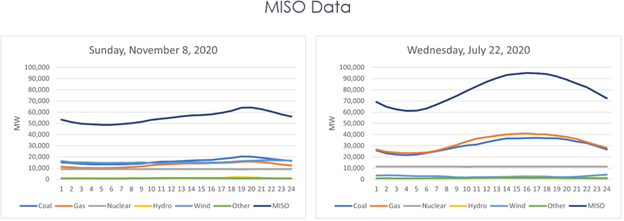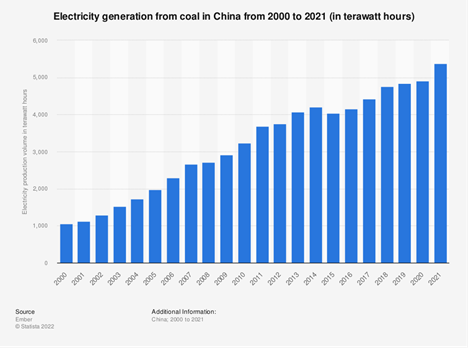
Last week I provided an extensive analysis of how Chernobyl’s RBMK reactor design and the chain of reckless events led to its 1986 disaster. The study sets the stage to explain why that won’t happen with power plants in the United States.
Let’s take a minute to examine why nuclear power is a good fit for our needs.
Nuclear Power’s Plug into Our Grid
Commercial nuclear power plants operate continuously at full power for 90-95% of the year. They require an average of three to four weeks a year for maintenance and refueling. One charge of nuclear fuel, about 3% uranium isotope 235 (U235), provides about two years of power. Maintenance and refueling occur in the shoulder months when the weather is cool, and grid loads are low.
Data from the Midcontinent Independent System Operator, MISO, shows how strong the baseload is on a shoulder day in November and on a high-demand day in late July. Existing nuclear, at 10 GW, has plenty of headroom to expand to the minimum annual baseload of 50 GW. Notice how wind generates about 17,000 MW in November and zero MW during peak grid load in July. It’s simple physics.
 Fukushima
Fukushima
People lost their minds and clear thinking in the wake of the Fukushima Daichi wipeout caused by a tsunami triggered by a 9.0 earthquake off Japan’s main island in 2011. Ten years after the tsunami, Japan operates nine reactors, down from 54 at the time of the tsunami. Germany’s nuclear plants would be closed by now if not for physics.
The New York Times (the NYT!) reported in 2015 that the leveling of Fukushima caused zero deaths or sickness from radiation, but 1,600 people died in the scramble to evacuate. “The government basically panicked,” a doctor quoted in the article said.
Nuclear Power Plants Emit Radioactive Materials?
According to Oak Ridge National Laboratory, “the world’s coal-fired power stations currently generate waste containing around 5,000 tonnes of uranium and 15,000 tonnes of thorium. Collectively, that’s over 100 times more radiation dumped into the environment than that released by nuclear power stations.” Collectively, that’s over 100 times more radiation dumped into the environment than that released by nuclear power stations [sic].
Remember, China continues to expand coal burning like mad, AND its emissions are not contained in concrete containers but spewed into the planet’s atmosphere.
 Avoiding Fukushima-like Reactor Damage
Avoiding Fukushima-like Reactor Damage
Some of nuclear power’s risk is loss of cooling during an accidental shutdown due to something like, oh, a tsunami. Fukushima’s backup generators were flooded with seawater. The Chernobyl disaster was caused by a test of the backup system. Backup systems aren’t necessary with a decent design that deploys natural circulation. Some submarine reactor plants may use such a design for quiet operation. Why mess around with all the complex hassle of IC engines, switches, valves, and a billion points of potential failure when physics can take care of it with nothing but a design?
Nuclear Power’s High Cost?
This month’s Public Utilities Fortnightly includes an interview article, New Nuclear’s Role in Decarbonization, with Ted Nordhaus from the Breakthrough Institute and John Kotek from the Nuclear Energy Institute. Nordhaus is quoted as saying, “we are not going to build a lot of large, one-gigawatt light-water reactors in this country for a long time.” Their site indicates they are proponents of small modular reactors, SMRs. There is a prominent place for those, but why can’t we build anything large these days, like the Hoover Dam, Robert Moses Power Station, or Vogtle power plants? In part due to a few letters like EPA and NIMBY.
Vogtle plants three and four are the first nuclear plants to be built in 30 years in the U.S. They are 100% over budget. Well, duh. That would make me one of the 25% in the workforce then and now, considering 30 years is 75% of a career. How can anyone expect to roll things out efficiently and inexpensively and at a blazing pace of one per career? Those plants will operate longer than nearly everyone reading this article – 60 to 80 years.
Kotek says, “there is value in having this firm, clean generation” running 24/7 to “complement intermittent wind and solar.” Compliment? Nuclear power will run wind and solar into the ground. Sixty to eighty years! Nordhaus later says: “Nuclear is the least-cost pathway to a low-carbon grid,” “as opposed to massively overbuilding renewables, even if you can build them at that scale. Renewables at those scales have their own, call it social license problems.” Kotek cleans up, “multi-state transmission has proven to be even more difficult [than nuclear].”
Modular
Breakthrough defines modular reactors as 300 MW and smaller. I assume that is MWelectric rather than MWthermal because they say gas and coal plants in the range of 300 MWe are common, which is true. This returns us to the White Rabbit post and C2N, or coal to nuclear, conversions. At scale, they could be great opportunities for retrofitting or replacing coal plants with continuous duty, zero-carbon power with no added footprint for decades.
Nuclear Waste
All forms of electricity have waste. Where are the used wind turbine and solar panels going? What about all the one-thousand-pound Li-ion batteries? At least like those things, and unlike the tons of thorium and uranium spewed by coal plants, they are or will be contained in safe packages. Naval reactor plant compartments are safely stored in Washington, as shown here.
Conclusion
In conclusion, this winter, Europe will demonstrate the harsh realities of undiversifying their energy and power supplies and that total renewable is not viable compared to many other options. Will our betters learn from this, or will they relive it again and again? China, India, Russia, and the UAE lead the world in nuclear plant construction today, with 55 plants under construction, adding to the 440 operating today.

 Fukushima
Fukushima




